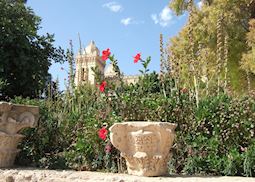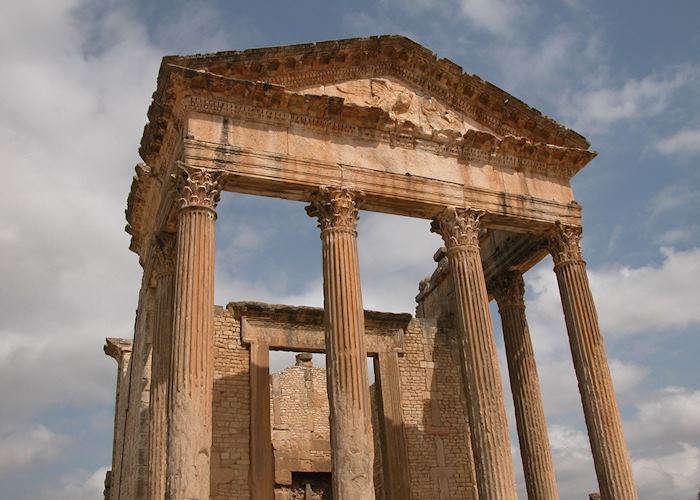While some might argue that Tunisia does not possess a stunning draw such as the Pyramids of Giza of the ancient city of Petra, there is little doubt that Dougga is the pinnacle of the Roman presence in Tunisia, and looks out majestically over the hills. It can be found just over an hour away from Thuburbo Majus, and between two and two-and-a-half hours from Tunis. What perhaps makes it so aesthetically pleasing is its geography — perched on high, it is a picture of verdancy and her stone columns stand proudly against the green countryside. It occupies an unusual position for a Roman town because its origins date back well before the Romans — in fact, it was a Numidian stronghold, and enjoyed great prosperity through Masinissa, its ruler. Masinissa allied himself to the Romans rather than the Carthaginians, and the town, and its probable 10,000 residents, thereafter found great favour.
Although the Temple of Saturn is perhaps the first monument you will see while taking the narrow roads uphill to the site, a visit to Dougga invariably begins with the Theatre, whose splendour is unchallenged by its nearness to the car park. Built in 168 AD by one of the town's wealthier occupants, Marcus Quadratus, the Theatre can seat up to 3,500 people.
The majority of Dougga as a town sits lower on the hill than the Theatre, and you walk down to it. One of the first things to confront you is the Capitol, which has six columns, each eight metres high. The square beside is believed to have been a marketplace. It is from here that you find the residential quarter, Temples, and extensive Licinian Baths, and there are some choice spots down here to photograph the Capitol.
It is testament to the beauty of Dougga that it can be considered the highlight of all the many Roman sites within the country. To visit it properly one ought to allow around three hours. There is a further hour's drive to Bulla Regia.
Bulla Regia is a remarkable Roman city, in northwestern Tunisia, near the modern city of Jendouba. It is celebrated for its semi-subterranean housing, a feature that most likely was a response to the need for protection against excessive heat in summer and the cold in winter. The experience of exploring complete, superbly preserved villas is quite incredible; Bulla Regia remains a unique Roman city in having two storey dwellings with one floor underground.
The subtle colours and shading and the three-dimensional forms of the finest mosaics at Bulla Regia are unsurpassed in all North Africa, where the Roman art of mosaic floors reached its pinnacle. The mosaic of a haloed Amphitrite, a sea-goddess, is often illustrated. Many of the mosaic floors have been left in situ and there is also a small museum connected with the site. Some of the finest exhibits in the Bardo Museum originate from Bulla Regia.
The date of Bulla Regia's foundation is not known but imported Greek ceramics dating back to the beginning of the 4th century BC have been found on the site. Romanisation of the city occurred gradually, following the destruction of Carthage. The citizens of Bulla Regia themselves encouraged Romanisation, in the first century the town became a municipium and in the second century a colony (This status gave the inhabitants full Roman citizenship). It was only in the third century that the public buildings, symbols of Roman civilisation, were erected. Rich families felt obliged to offer the city its infrastructure, public buildings and leisure facilities to keep a better hold on power.
During the Byzantine era, the city declined. For reasons of defence, fortifications were built at the expense of existing monuments. Essentially the city of Bulla Regia had collapsed by the sixth century; drifting sand protected the abandoned sites, which were forgotten until the first excavations began in 1906.
At the end of the day you will drive back from Bulla Regia to your hotel. The journey will be direct along good roads, and should take between two and two and a half hours.






